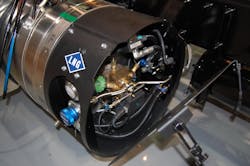Dual-fuel system aims to lower NGV transition costs
Despite the U.S. trucking industry's growing interest in using natural gas to power its vehicles, many motor carriers remain stymied by the high sticker price for trucks designed to run on either compressed natural gas (CNG) or liquefied natural gas (LNG) as well as by the lack of natural gas refueling locations across the country.
As result, several firms are offering fleets a way to split the difference via lower-cost retrofit “dual fuel” systems – allowing trucks to operate on CNG or LNG and diesel, while eliminating concerns about the adequacy of natural gas refueling locations.
“The key is giving the fleet owner a safety net to address 'range anxiety' as well as a lower-cost way to tap into the benefit of using less expensive natural gas where available,” Lyle Jensen, CEO of American Power Group (APG), told Fleet Owner.
“We also think dual -fuel technology allows any trucking firm, from large national fleets down to owner-operators, to tap into natural gas without extensive challenges,” he explained.
Jensen noted that APG’s turbocharged natural gas systems – which he said met Environmental Protection Agency (EPA) alternative fuel conversion standards in April 2011 – offers a 300 to 800-mile dual fuel range with diesel-equivalent power and torque. Depending on the route profile, Jensen said APG’s system can deliver average annual net fuel savings of 15% to 30% compared to operating on 100% diesel fuel.
He added that APG’s system is currently EPA-approved for 88 engine families and is expected to receive EPA approval for more than 200 additional engine families by the end of 2013.
More importantly, for Class 8 units, the premium for APG’s retrofit system – including installation fees and natural gas storage tanks – can be significantly less compared to a tractor equipped with a dedicated natural gas engine.
Jensen said the premium typically runs between $22,000 for a CNG-based dual fuel system up to $25,000 for an LNG-based one -- compared to the $27,000 to $72,450 average premium range for a dedicated natural gas tractor, a figure calculated by global consulting firm Frost & Sullivan for its Strategic Analysis of the North American Class 6-8 Natural Gas Truck Market report.
That steep up-front cost is one reason Frost & Sullivan predicted that the number of natural gas-powered trucks in the medium and heavy-duty commercial trucking segment would only grow slowly, from 1,950 units today to over 29,483 units in 2017 – making up just 8% of total Class 6-8 production six years from now.
To provide fleets with simplified installation and maintenance service for its dual-fuel product, APG recently forged and agreement with WheelTime Network LLC. APG’s Jensen said WheelTime’s 18 member companies – providing installation and warranty support through nearly 200 nationwide service centers, staffed with 3,000 factory-trained technicians – not only offers support for his company’s product but also allows fleets with older trucks to take advantage of fuel cost savings by using natural gas.
“We believe diesel engine dual-fuel conversions will be an evolutionary step for natural gas, providing a low risk way for fleets to get the benefit of natural gas fuel savings and giving existing equipment new life,” said Mike Delaney, WheelTime’s president & CEO.
“Fleets obviously see an ROI [return on investment] by switching to natural gas, but the costs are very high to go with a dedicated product,” Delaney told Fleet Owner. “With the dual-fuel option, fleets can change their fuel cost footprint starting on day one and, through us, they have the installation and maintenance support without having to invest in it themselves.”
About the Author
Sean Kilcarr
Editor in Chief
Sean Kilcarr is a former longtime FleetOwner senior editor who wrote for the publication from 2000 to 2018. He served as editor-in-chief from 2017 to 2018.
